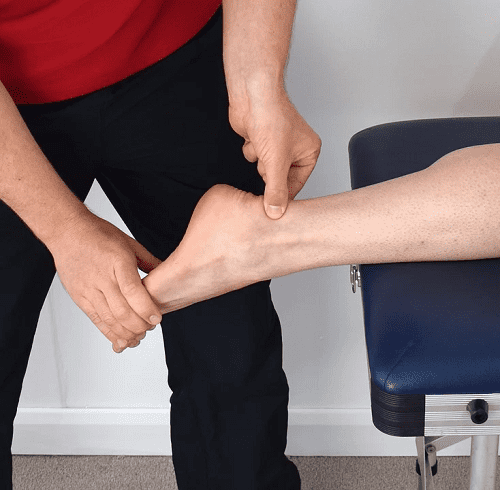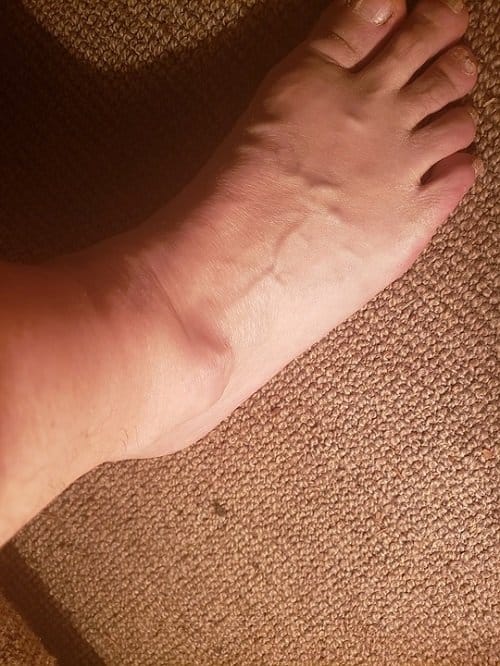Statistics indicate that more than two million people in the US seek medical attention for ankle injuries annually, and 40% of ankle sprains can potentially result in chronic issues. Moreover, an ankle sprain can happen to anyone while walking, running, or engaging in some physical activity. Although minor ankle sprains may not require medical intervention, severe sprains that involve bone fractures will need medical treatment. However, it’s always a wise idea to consult your doctor since it might be difficult to evaluate the seriousness of the sprain on your own. This article highlights ways to shower with a sprained ankle plus tips on how to speed up the recovery process.
Symptoms of an Ankle Sprain
Common symptoms of an ankle sprain may include:
- Sudden pain after rolling or twisting the ankle
- Bruising
- Swelling
- Tenderness when touched
- Inability to walk normally
- Pain and swelling that persists for a day or two
- Limited range of motion around the ankle joint
- Numbness or weakness in the ankle
- Inability to bear weight on the affected leg
- Reduced blood circulation in the area
If you have any doubt about whether your ankle is fractured or sprained, seek medical attention immediately.
How to Shower With a Sprained Ankle
Once you’re back from the hospital with a mobility device, you’ll be able to get around your home and rest on your couch as you recover gradually from the ankle sprain. Unfortunately, your bathroom isn’t optimized for your sprained or fractured ankle.
A seemingly simple daily routine like showering may become complicated and frustrating when dealing with a sprained ankle, especially with a large cast in tow. So, you’ll need to follow expert advice on how to shower with a sprained ankle to prevent unpleasant experiences. More importantly, you need to incorporate your doctor’s advice with the tips we’ll share in this article. Overall, your showering approach will differ depending on whether you’re wearing a boot or a cast.
Get an Assistant
Bathrooms are notorious fall hazards. Whenever possible, have someone around to help you move in and out of the shower to avoid falling. Typically, your balance may be off the first few days you take a shower. Just ensure your assistant is comfortable with this assignment to make things smooth for both parties.
Avoid Full Showers
It’s often a nuisance wrapping up your cast or boot in a plastic bag whenever you take a shower. If possible, take a seated shower with your affected leg rested on a stool to prevent water from dripping and soaking your cast or boot. Alternatively, you can have your assistant aid you into a bathtub with your ankle set up on the side of the tub. This helps keep your injured foot out of the water, ensuring that your cast or boot is always nice and dry. Once you’re done, you can call your assistant to help you out of the tub.
Take a Seated Shower
If you find it hard to bathe, consider turning your shower into a sprained ankle-friendly oasis. You can purchase a plastic stool or lawn chair you can comfortably sit on while showering. Place the seat at the center of the shower and ensure your body washer, shampoo, conditioners, and other essentials are well within reach.
Next, find a large plastic bag such as a kitchen trash bag or garbage bag and wrap it around your boot or cast. Additionally, tape the upper part of the plastic bag just above your boot or cast to make it waterproof – avoid duct tape since it’s hard to get off.
Once you’re properly prepared for the shower, sit on the stool and turn on the water to enjoy a luxurious, therapeutic shower. When done, you can dry your body with a towel and carefully cut off the plastic bag.
Clean Your Boot or Cast
After you’ve showered and made your body clean and refreshed, it’s wise to do the same for your cast or boot. Just use a simple mixture of water and household bleach to make a mild cleaning solution that kills any nasty germs that may linger on your cast or boot. Make sure the bleach solution does not exceed the 1:10 mark (one part of bleach mixed with ten parts of clean water). Now, use a clean towel to gently scrub the cast/boot down to dry it out.

Other Ways to Speed Up the Recovery Time
Other than having therapeutic showers, you’ll need to practice other home remedies to speed up the recovery time and get back to your normal routine. Here are some ways you can aid healing for a sprained ankle:
1. RICE
RICE simply means rest, ice, compression, and elevation. Every parent and athlete knows this age-old remedy for minor muscle sprains and strains, and doctors also recommend it because it’s effective.
- Rest: Be sure to stay off the injured leg for a few days and get adequate rest.
- Ice: Press cold ice to the sprained ankle multiple times a day to reduce pain and swelling.
- Compression: If you have no boot or cast, apply an elastic or static compression bandage to limit swelling.
- Elevation: Keep the injured ankle above your heart to reduce the flow of blood and other body fluids to the injury site.
RICE therapy might seem simple, but it’s been found to be very helpful during ankle sprain recovery. Start it as soon as possible after the sprain in order to help control your body’s natural inflammatory response.
2. Epsom Salt
After a few days, try soaking your injured ankle in a warm bath of Epsom salt. Apply cold baths during the first few days of the injury. Overall, Epsom salt helps soothe sore connective tissues and muscles, which helps with joint stiffness. Try adding Epsom salt to a warm bath 1-2 times each day as the healing progresses.
3. Natural Poultices
Your pantry contains a variety of natural anti-inflammatory ingredients. Consider a traditional poultice such as onion, garlic, olive oil, castor oil, or turmeric to help minimize swelling. Gently heat the ingredients and apply to your sprained ankle and wrap the ankle in a clean bandage for several hours.
4. Cold Compression Therapy
You can take RICE therapy to the next level by renting a cold therapy system to use at home. Cold and compression therapy uses the RICE therapy concept but adds modern technology such as elevation extremity.
Since the water is constantly circulating around your ankle, it maintains a consistent temperature level throughout the therapy. Besides, the pressurized air generates a pumping effect that mimics the natural “squeeze and release” of muscles to help reduce swelling.

5. OTC Pain Medication
A sprained ankle may sometimes be extremely painful. If you find the pain and discomfort too much to endure, you can take over-the-counter pain medication to reduce the pain and swelling. However, you need to consult your doctor and always adhere to the dosage instructions to ensure safe use.
Frequently Asked Questions About Sprained Ankles
People with ankle sprain injuries often ask a lot of questions, especially about how long it takes to recover fully and how to speed up the healing process. Some of the most frequently asked questions about ankle sprains include:
How long does it take to heal from a sprained ankle?
How long it takes to heal from a sprained ankle will depend on a number of factors, such as the severity of the injury, the treatment approach you take, how much rest you get, and your overall health. In general, healing times may be as follows:
- Mild ankle sprains: 1-2 weeks
- Moderate ankle sprains: 4-6 weeks
- Severe ankle sprains: 8-12 weeks
In severe cases, an ankle sprain may require physical therapy or surgery to fully support recovery.
How long do you need to stay off a sprained ankle?
You need to avoid putting pressure on the sprained ligaments in your ankle as long as you can to give it more opportunity to heal. However, life must move on even when you’re injured. If you must move around, try to stay off the injured leg completely by using crutches for at least 2-3 days. Afterward, you can use a rigid boot brace whenever you’re walking around. If you feel pain putting weight on the ankle, avoid walking on it. More importantly, seek medical attention if you’re unable to move about for more than a few days.
How can I make a sprained ankle heal faster?
The treatment options we’ve discussed above may support healing for an ankle sprain. Just ensure you stay off the affected foot and wear a supportive brace to help immobilize the ankle joint and allow the damaged tissues to heal. Additionally, get ample rest and eat a well-balanced diet to give your body what it takes to support healing.
Can I walk on a sprained ankle?
The general rule of thumb is that if you feel extreme pain in your ankle when you place weight on it, avoid walking on it. Instead, use crutches during the first few days of the injury. As the healing progresses, use an ankle boot or brace to provide support. And when you begin walking on your sprained ankle with comfort, avoid running or engaging in strenuous activities that could reverse the progress.
Wrapping Up
So, that wraps it on how to shower with a sprained ankle and some helpful tips to help you speed up the recovery time. If you’re not sure which sprained ankle remedy is right for you, be sure to consult with your physician. From our end, we can only recommend therapeutic handheld showerheads to aid your bathing experience.
